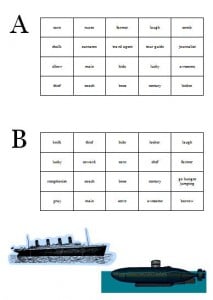Vocabulary Battleships
What do we do with emergent language?
At the end of every lesson, my teenagers write new vocab on slips of paper and put them into an envelope…but then I wanted to find ways of encouraging them to use and review the vocabulary. So, yesterday I played “Vocabulary Battleships” with my students. It’s easy to prepare, provides lots of communicative practice and is an engaging way to review vocabulary.
In preparation, you’ll need to provide two boards – A and B – with the vocabulary you want to focus on. You can use some of the same vocabulary on both boards or make them completely different. Then divide the class into As and Bs and instruct everyone to draw 6 ships on their board, keeping it a secret from their partner.
To play, A describes a word on B’s board, hoping there’s a battleship in that square; and vice versa. I’m going to try it with my adult C1 group in the future as well as they enjoy review activities and we have an abundance of new language coming out of each lesson.

